Input interpretation

1, 1, 2-trichlorotrifluoroethane
Basic properties
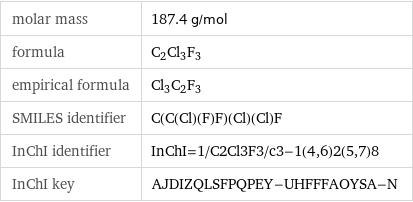
molar mass | 187.4 g/mol formula | C_2Cl_3F_3 empirical formula | Cl_3C_2F_3 SMILES identifier | C(C(Cl)(F)F)(Cl)(Cl)F InChI identifier | InChI=1/C2Cl3F3/c3-1(4, 6)2(5, 7)8 InChI key | AJDIZQLSFPQPEY-UHFFFAOYSA-N
Lewis structure

Draw the Lewis structure of 1, 1, 2-trichlorotrifluoroethane. Start by drawing the overall structure of the molecule: Count the total valence electrons of the carbon (n_C, val = 4), chlorine (n_Cl, val = 7), and fluorine (n_F, val = 7) atoms: 2 n_C, val + 3 n_Cl, val + 3 n_F, val = 50 Calculate the number of electrons needed to completely fill the valence shells for carbon (n_C, full = 8), chlorine (n_Cl, full = 8), and fluorine (n_F, full = 8): 2 n_C, full + 3 n_Cl, full + 3 n_F, full = 64 Subtracting these two numbers shows that 64 - 50 = 14 bonding electrons are needed. Each bond has two electrons, so the above diagram has all the necessary bonds. There are 7 bonds and hence 14 bonding electrons in the diagram. Lastly, fill in the remaining unbonded electrons on each atom. In total, there remain 50 - 14 = 36 electrons left to draw: Answer: | |
Estimated thermodynamic properties
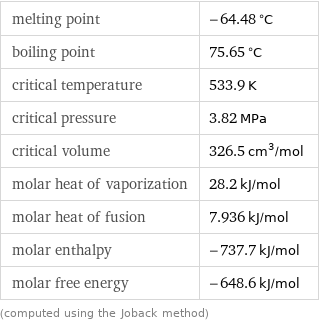
melting point | -64.48 °C boiling point | 75.65 °C critical temperature | 533.9 K critical pressure | 3.82 MPa critical volume | 326.5 cm^3/mol molar heat of vaporization | 28.2 kJ/mol molar heat of fusion | 7.936 kJ/mol molar enthalpy | -737.7 kJ/mol molar free energy | -648.6 kJ/mol (computed using the Joback method)
Units

Quantitative molecular descriptors
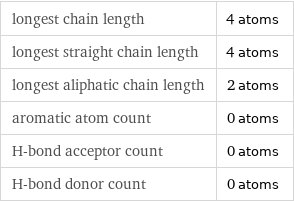
longest chain length | 4 atoms longest straight chain length | 4 atoms longest aliphatic chain length | 2 atoms aromatic atom count | 0 atoms H-bond acceptor count | 0 atoms H-bond donor count | 0 atoms
Elemental composition

Find the elemental composition for 1, 1, 2-trichlorotrifluoroethane in terms of the atom and mass percents: atom percent = N_i/N_atoms × 100% mass percent = (N_im_i)/m × 100% Plan: • Write the chemical formula and gather atomic masses from the periodic table. • Determine values for N_i, m_i, N_atoms and m using these items. • Finally, compute the percents and check the results. Write the chemical formula: C_2Cl_3F_3 Use the chemical formula to count the number of atoms, N_i, for each element and find the total number of atoms, N_atoms, per molecule: | number of atoms Cl (chlorine) | 3 C (carbon) | 2 F (fluorine) | 3 N_atoms = 3 + 2 + 3 = 8 Divide each N_i by N_atoms to calculate atom fractions. Then use the property that atom fractions must sum to one to check the work: | number of atoms | atom fraction Cl (chlorine) | 3 | 3/8 C (carbon) | 2 | 2/8 F (fluorine) | 3 | 3/8 Check: 3/8 + 2/8 + 3/8 = 1 Compute atom percents using the atom fractions: | number of atoms | atom percent Cl (chlorine) | 3 | 3/8 × 100% = 37.5% C (carbon) | 2 | 2/8 × 100% = 25.0% F (fluorine) | 3 | 3/8 × 100% = 37.5% Look up the atomic mass, m_i, in unified atomic mass units, u, for each element in the periodic table: | number of atoms | atom percent | atomic mass/u Cl (chlorine) | 3 | 37.5% | 35.45 C (carbon) | 2 | 25.0% | 12.011 F (fluorine) | 3 | 37.5% | 18.998403163 Multiply N_i by m_i to compute the mass for each element. Then sum those values to compute the molecular mass, m: | number of atoms | atom percent | atomic mass/u | mass/u Cl (chlorine) | 3 | 37.5% | 35.45 | 3 × 35.45 = 106.35 C (carbon) | 2 | 25.0% | 12.011 | 2 × 12.011 = 24.022 F (fluorine) | 3 | 37.5% | 18.998403163 | 3 × 18.998403163 = 56.995209489 m = 106.35 u + 24.022 u + 56.995209489 u = 187.367209489 u Divide the mass for each element by m to calculate mass fractions. Then use the property that mass fractions must sum to one to check the work: | number of atoms | atom percent | mass fraction Cl (chlorine) | 3 | 37.5% | 106.35/187.367209489 C (carbon) | 2 | 25.0% | 24.022/187.367209489 F (fluorine) | 3 | 37.5% | 56.995209489/187.367209489 Check: 106.35/187.367209489 + 24.022/187.367209489 + 56.995209489/187.367209489 = 1 Compute mass percents using the mass fractions: Answer: | | | number of atoms | atom percent | mass percent Cl (chlorine) | 3 | 37.5% | 106.35/187.367209489 × 100% = 56.76% C (carbon) | 2 | 25.0% | 24.022/187.367209489 × 100% = 12.82% F (fluorine) | 3 | 37.5% | 56.995209489/187.367209489 × 100% = 30.42%
Elemental oxidation states
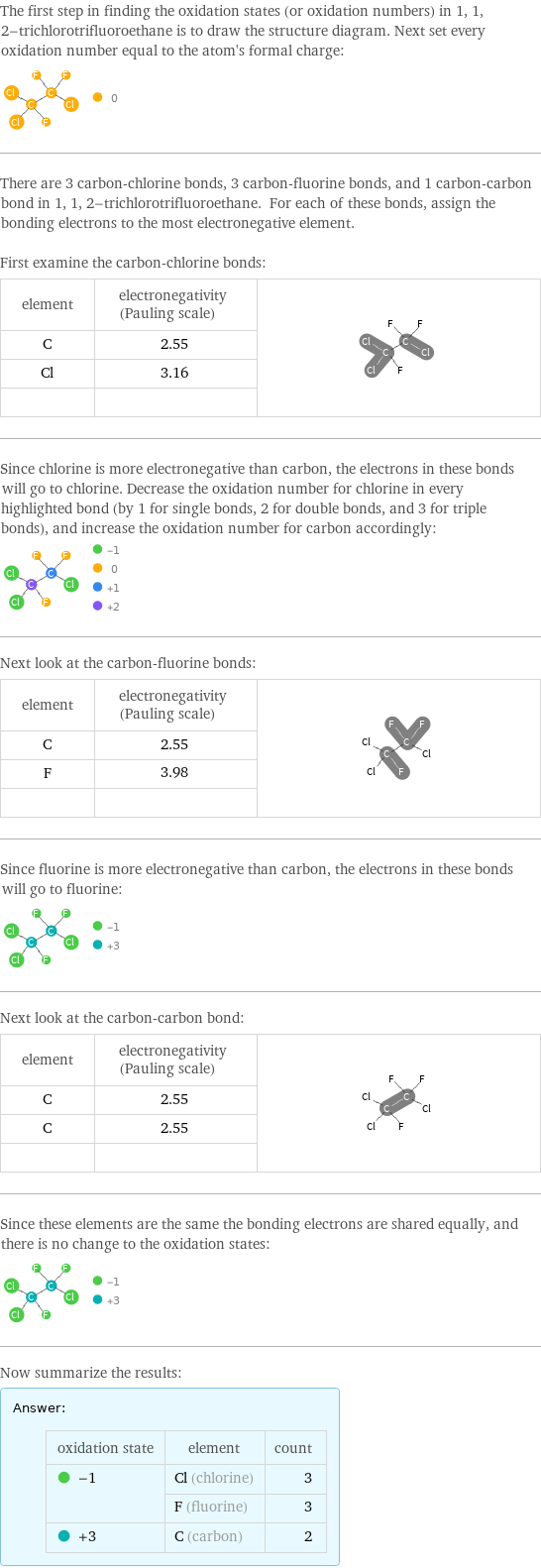
The first step in finding the oxidation states (or oxidation numbers) in 1, 1, 2-trichlorotrifluoroethane is to draw the structure diagram. Next set every oxidation number equal to the atom's formal charge: There are 3 carbon-chlorine bonds, 3 carbon-fluorine bonds, and 1 carbon-carbon bond in 1, 1, 2-trichlorotrifluoroethane. For each of these bonds, assign the bonding electrons to the most electronegative element. First examine the carbon-chlorine bonds: element | electronegativity (Pauling scale) | C | 2.55 | Cl | 3.16 | | | Since chlorine is more electronegative than carbon, the electrons in these bonds will go to chlorine. Decrease the oxidation number for chlorine in every highlighted bond (by 1 for single bonds, 2 for double bonds, and 3 for triple bonds), and increase the oxidation number for carbon accordingly: Next look at the carbon-fluorine bonds: element | electronegativity (Pauling scale) | C | 2.55 | F | 3.98 | | | Since fluorine is more electronegative than carbon, the electrons in these bonds will go to fluorine: Next look at the carbon-carbon bond: element | electronegativity (Pauling scale) | C | 2.55 | C | 2.55 | | | Since these elements are the same the bonding electrons are shared equally, and there is no change to the oxidation states: Now summarize the results: Answer: | | oxidation state | element | count -1 | Cl (chlorine) | 3 | F (fluorine) | 3 +3 | C (carbon) | 2
Orbital hybridization
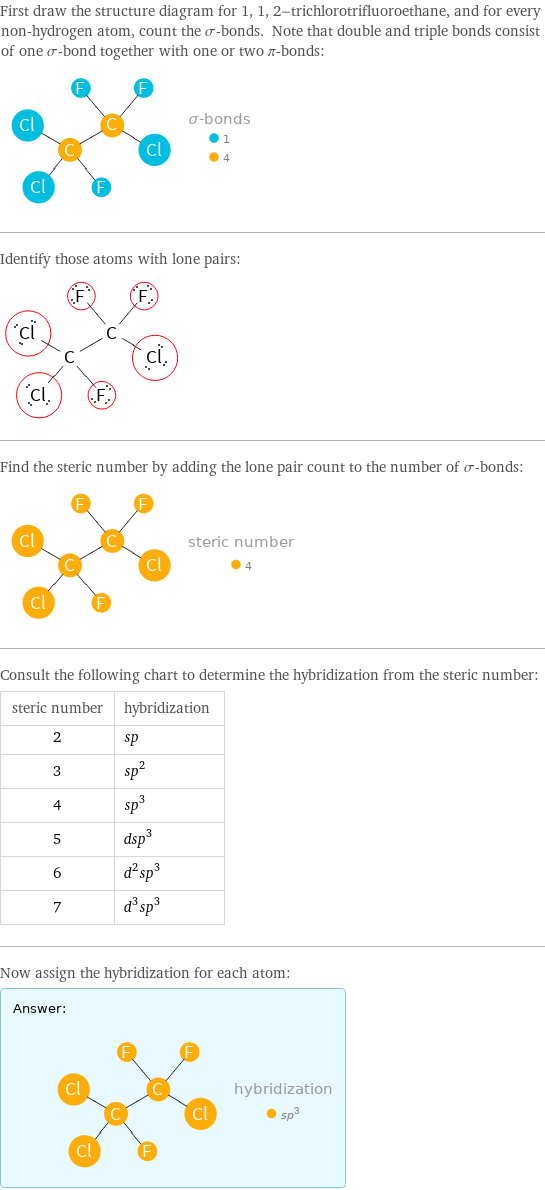
First draw the structure diagram for 1, 1, 2-trichlorotrifluoroethane, and for every non-hydrogen atom, count the σ-bonds. Note that double and triple bonds consist of one σ-bond together with one or two π-bonds: Identify those atoms with lone pairs: Find the steric number by adding the lone pair count to the number of σ-bonds: Consult the following chart to determine the hybridization from the steric number: steric number | hybridization 2 | sp 3 | sp^2 4 | sp^3 5 | dsp^3 6 | d^2sp^3 7 | d^3sp^3 Now assign the hybridization for each atom: Answer: | |
Topological indices
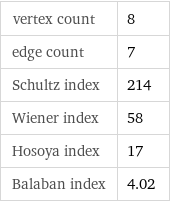
vertex count | 8 edge count | 7 Schultz index | 214 Wiener index | 58 Hosoya index | 17 Balaban index | 4.02